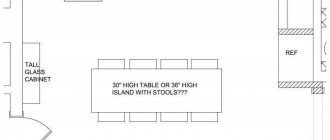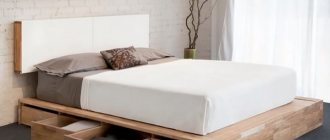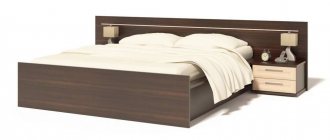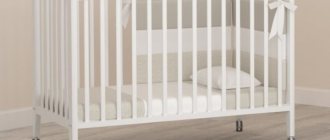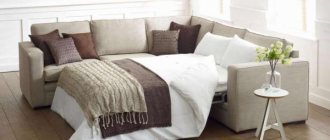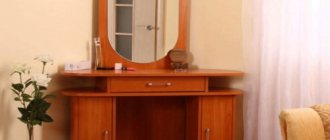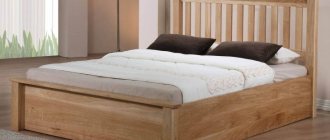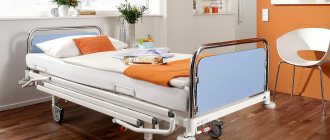Today, many consumers are interested in making their own furniture. The number of home craftsmen is increasing all the time. Some of them purchase construction blanks from furniture factories, while others prefer to manufacture products according to their own designs. A do-it-yourself children's car bed can be made with all sorts of decorative elements or have a very simple look. It depends on the personal preferences of the child, parent, and financial capabilities.
Assembling a pendulum crib
The pendulum crib differs from all other analogues by the presence of a baby rocking system. This function is very convenient for the first months of the baby’s life. However, difficulties may arise with the configuration of this model. But a further description of how to assemble a crib - a pendulum: instructions, photos and a step-by-step guide will help you deal with this issue.
This type of crib consists of a frame, bottom, sides, legs and a pendulum mechanism. Also, such models can be equipped with special drawers for baby clothes and linen. The mechanism itself can swing up and down. When the need for it disappears, the structure is fixed.
Assembly is carried out according to the following scheme
:
- You will need all the elements of the crib, a work plan, screws, damping devices and a screwdriver;
- The work area on the floor should be covered with a light cloth to prevent loss of elements;
- We fasten the static back wall with screws to the side backrests. To avoid confusing the top and bottom of the back wall, use the legs as a guide;
- The next stage is the installation of the bed. It can be either solid or slatted. The slats are inserted into special holes in the bar of the rear wall. At first, the stock is secured lightly with screws. The movable front part is attached to recesses on the side backs of the crib, which serve as guides. Next, the screw connection should be tightened more firmly;
- Next, the finished body can be turned over and the pendulum system can be assembled. If the model has linen drawers, they are placed in the internal space of the pendulum. Next, its side panel is secured with screws. The housing is mounted on the pendulum using bearings. Make sure that the notches of the clamps line up exactly. Caps cover screws for an aesthetic appearance.
A do-it-yourself crib for a newborn, carefully prepared for the baby, or purchased in a store that meets all safety requirements, will become the best place for your child to rest and sleep and will deservedly take a central place in the interior of the children's room. To carry out these manipulations, it is not necessary to call a specialist. Thanks to this guide on how to assemble a crib - pendulum (instructions, photos and recommendations), you yourself will cope with this task perfectly.
The birth of a child is a significant and joyful event in almost every family. However, at the same time there are various hassles associated with preparing the necessary space for a newborn baby. This primarily concerns the sleeping area. Few people can afford to buy a bed for newborns, given the prices today.
It must be remembered that the crib must be stable and safe for the child.
But there is an alternative option that will save money - a do-it-yourself crib for a newborn. And if you approach this matter very responsibly and with knowledge of the process itself, you will end up with a bed no worse than one purchased in a store.
Design Features
Children's beds are subject to much more stress than adults, despite the obvious difference in weight. The child is constantly and actively moving, and the bed, both regular and play, is constantly used not only for sleeping, but also for jumping, tumbling, climbing, playing hide and seek, and so on.
- Therefore, one of the main requirements for the model is the strength of both the material and the fasteners.
- The second is the correspondence of the size of the machine bed. A sliding bed cannot be designed in this way, so the parameters are selected for “growth”. On average, the period of use will be 2–3 years.
- Safety of design - material, paints, stickers, lighting, if expected, must comply with the required safety class.
Bed in the shape of a car (photo)
Frame
It is performed in two main modifications. The choice depends on desire, experience working with wood and the upcoming load - the weight of the main user.
- The frame itself - a frame on legs or a box, reinforced with transverse crossbars, is made of wooden beams 50 * 70 mm. The joints are reinforced with metal corners. If it is planned to install drawers, then instead of cross beams, plywood jumpers, or better yet boards, are fixed. The frame of the bed is assembled onto the frame, that is, the sides, back and headboard. This design is easy to manufacture and very reliable. The dimensions of the frame coincide with the parameters of the mattress plus 1–2 cm. The bottom can be installed solid from plywood 10 mm thick, but a slatted one will be much more useful. A set of slats along with lath holders can be purchased at any relevant store. Height is determined by the child's height. The frame can be installed directly on the floor, on legs or on casters.
- The second option is that the frame and frame of the bed are a single whole. In this case, the sidewalls, headboard and footboard perform the load-bearing role. The parts are cut out according to the developed template and then assembled. The mattress will be held by a frame made of beams, fixed to the inside of the sides and back. You can strengthen the model by using the simplest bedside tables as frame elements. The sides are fixed directly on them, the fronts of the bedside tables are designed as a footboard and headboard. And as a result, they get a machine bed with ready-made niches for blankets and linen. Chests of drawers with one drawer can be assigned to the same role; this option is even more convenient.
Do-it-yourself car bed (photo)
Side panels
They serve as the main design detail, giving the bed the contours of a car. Sidewalls are cut from plywood, chipboard, MDF or wood, depending on the features of the model and financial capabilities.
At the first stage, a project is developed. A specific model or an abstract image of a car is used as a sample, but even with the most basic calculations, there should be a drawing in front of your eyes with parameters, rounding angles and color. A template is made from the sketch and then cut out of the material.
The same is done for the headboard and footboard. The options are different: it is possible to install simple flat panels, where the resemblance to a car is achieved by the image of headlights, but you can develop a design that more accurately imitates a bumper.
There are two ways to make a machine bed with your own hands.
- If the elements are mounted on a frame, then special strength is not required from them. In this case, the sides and backs are cut from plywood 10 mm thick, or chipboard as desired.
- If the bed frame is the frame, then you will need chipboard, MDF or wood up to 18 mm thick.
In both cases, the workpieces are cut out with a jigsaw, cleaned, and the edge is processed with a milling cutter. The edge must be sealed with thermal tape or plastic edge.
The size and contours of the sidewall should take into account not only the resemblance to the model, but also convenience: it should be easy for the baby to climb over the sides.
Details and additions
The most obvious car accessories are the steering wheel and wheels. In the vast majority of cases, both in models of manufacturers and in-house production, they are absent. In principle, a steering wheel is not provided: it would have to be installed at the foot and the backrest should be made too high. They prefer to paint or stick on wheels.
- In vain, since making wheels is very simple. A disc is cut out of plywood, the contour is reinforced with plywood overlays - they imitate the bulge of a tire, and the end is covered with a plastic edge. You can simply paint the wheel or attach a simple plastic cap purchased from a car store to it. The wheels are installed stationary or allowed to rotate freely.
- Most often, the sides and backs are painted with suitable bright colors, achieving maximum resemblance to the selected model or focusing on beautiful airbrushes on real cars.
You can select an image on the Internet and print it on oracal film on a large-format printer. This image does not erase or fade. The typewriter bed can be decorated using a variety of stickers - inscriptions, emblems, slogans. Volumetric design details can be made from molding.
- If you have experience in drawing up electrical circuits, you can equip the bed with “headlights” from spotlights. Or do it even simpler: attach the LED strip along the rims of the wheels and the lower contour of the sidewalls. No knowledge is needed here, you just need to assemble a tape of sufficient length and attach the adapter. Painting and gluing of the sides and backs is done before the bed is assembled. If the child is already old enough, and even more so if he is interested in automotive topics, it is worth involving him in the design. He probably has more ideas.
Homemade bed-car
Few boys will refuse a car bed. And you don’t have to go to the store to please your child. Using plywood or MDF sheets, water-based paints and varnish, an ordinary sleeping place turns into a dream come true: a do-it-yourself children's bed in the shape of a Batmobile (or any other car) can be realized in a week of leisurely work in the evenings.
We make such a children's bed-car with our own hands
First, find an image of the car that suits you, find a program with the ability to visualize pictures. Having transferred the image, it can be divided into squares with a side of 100 mm - so that later it is easier to convert it to real scale. It’s most convenient if the entire part fits into a sheet of plywood or MDF you bought, it’s even better if you can make two side panels from one sheet... In general, select the dimensions, change the shape. Once you are satisfied with the result, you can transfer the design to the sheet.
Ready-to-work sketch with markings
It all starts with drawing the sheet into squares with a side of 100 mm.
We draw the sheet into squares
Referring to the existing sheet, transfer all the lines from the paper to the plywood. At first the lines are thin, after you have more or less drawn everything, you can outline the resulting contours with a thick line - it will be easier to cut out. Although the details are needed in duplicate, there is no point in drawing the second one: having cut out the first one, we will outline it and get the second one.
Transferring the drawing to a larger surface
This project also has overhead parts - we draw them separately. When everything is ready, take a jigsaw and cut along the contours.
Cut parts
The edges turned out to be far from perfect, so we sand them well with a machine or by hand. Then we start cutting out recesses, holes, etc. The technique is traditional - we use a drill, drilling one hole next to another, then we file the jumpers. We grind the uneven edge in any available way, rounding it, and everything should be even and smooth both outside and inside.
We are working on design elements
After working out all the details, this is what happened.
Parts ready for painting
Primer and painting
For painting you need to choose safe materials. The best option is a water-based latex, and to protect the paint from scratches and abrasion, a water-based varnish is suitable.
If the parts are made of MDF, it is very advisable to prime everything, and preferably twice. This material can absorb paint very strongly, especially at the ends. The primer significantly reduces absorption, and the paint also lays down in a more even layer.
Parts are primed and dry
After the soil had dried, the areas that should be gray were painted first. By design, there are also thin gray stripes. In order not to paint them on black, a thin strip of masking tape (3 mm) is glued over the paint, and by removing it we can then obtain the desired design.
First we paint it with gray color, after drying we glue a thin strip of tape on it
Painting is almost complete
Assembling the car bed
We take one side panel and attach a wooden plank 25*25 mm minimum to it with self-tapping screws. We install self-tapping screws every 20-30 cm. At the front, we attach a limiter board to the end of the plank. We repeat the same operation on the second part (be sure to fasten the planks at the same height).
We nail the strips, install stoppers with magnets for attaching the headboard and shelves
Having installed the second part, we twist the structure. In the middle you need to install a stop bar that will firmly hold both sides and prevent them from moving apart.
Approximately in the middle we install a stop - a bar that fixes the required width of the bed
Cut planks are placed on the slats attached to the sides, like a frame, to serve as support for the mattress. They can be secured with self-tapping screws (two on each side), or they can simply be laid down. In this case, the bed will quickly disassemble. In this option, the second method was chosen - the slats were not fixed, the mattress was laid on them.
Laying the planks
A bed for a girl is made based on the same design. The shape of the railings is simpler, there is less work to do with them, but painting is more difficult. So it also has its moments.
DIY children's bed for a girl
Authors' Comments
For a clearer understanding, please read the authors' comments.
Since two people with different education, from different fields of activity and different experience were involved in the development and manufacture of a children's bed, deviations from the project began at the very beginning of the assembly.
1. The metallized edging included in the project was not available for sale; it had to be replaced with laminated chipboard (beech) close to the texture; The same fate befell the reinforced eccentrics (more precisely, they were on sale, but in wholesale quantities) - they had to be replaced with regular ones (this change is reflected in the design documentation).
2. It was proposed to fasten the beam for fastening the lath holders not from the inside with 14 screws each, but from the outside with only 5; At the same time, cover the countersunk holes (in which the screw heads are buried) with epoxylin.
The proposal is justified - the total twisting length in the second case is slightly less than the total length of the first option, but in this case the beam is attracted to the sidewall with great force and there is no need to glue the beam and the sidewall and, therefore, to prepare the surface of the sidewall for gluing.
3. Points not reflected in the documentation:
- install dowels with glue,
- fix the lath holders with a furniture bracket of 11-12 mm (quite enough - a longer bracket and, accordingly, a larger diameter can split the lath holder),
- The design documentation states, however, I repeat - the batten should not stand up in the batten holders by surprise, it should be able to move within 5 mm.
4. For a person familiar with the oracle sticker, this operation will not cause difficulties.
- the surface must be smooth and clean,
- the sticker must be guided through the water - this makes it easier to smooth the film and expel air bubbles,
- the film with the applied pattern is very unstable to mechanical influences (I do not rule out that printing on other, more resistant media is also possible), so a transparent oracal was glued on top of it (the so-called “cold lamination”); Notes specifically on this point - the sticker should also be placed on water; It is advisable to use boiled water without impurities (we had some streaks under the oracle, the nature of which we could not determine),
- As a squeegee, use a fairly hard (and clean, free of foreign inclusions) felt; using a rubber squeegee can cause streaks and scratches in the drawing.
5. The profile was glued with Titan glue along the untreated (in the sense of unedged) end; I’m almost sure that this glue is far from the best material, but... “I made it from what I had...” (there was nothing else at hand and accessible...). The very presence of this profile is explained by the need to protect the edges of the films (patterned and transparent) from scuffing, which could ultimately lead to their (the films) peeling. During the work on this item, the following considerations arose:
- It would probably be more correct to first glue the 0.4 mm PVC edge, then apply the design, and only then sculpt the profile - this way the adhesion of homogeneous materials would certainly be higher.
- It would probably be more technologically advanced to apply the design using ultraviolet printing (however, the resistance of such a design to mechanical influences is unknown, and the cost of the issue is unknown...).
- the feasibility of using a T-shaped mortise profile is, in my opinion, questionable; I'm not sure if this is a better solution.
That's how all the comments are.
PS: The designer does not want to give away full-color and full-size drawings suitable for printing (tiff, 300dpi) for “just like that.” So either use jpg, or draw it yourself, or something else (for example, buy it).
Necessary materials, tools, cutting and bed design
Materials:
- sheet of plywood or MDF 12 mm thick (1 pc.);
- boards 2.5×30×240 cm (3 pcs.);
- board 2.5×20×240 cm (1 pc.);
- board 2.5×10×240 cm (1 pc.);
- board 2.5×7.5×240 cm (1 pc.);
- boards 2.5×5×240 cm (3 pcs.);
- decorative strips 6 mm thick;
- 50 mm self-tapping screws;
- 50 mm nails;
- 30 mm nails;
- 15 mm parquet nails;
- glue;
- wood putty;
- sandpaper;
- hinges (strong door hinges or special hinges for folding beds);
- heavy-duty magnetic latch that can hold the bed in the raised position and prevent it from tipping over;
- hinges with a closer for slowly lowering the bed to a horizontal position.
Tools:
- roulette;
- square;
- pencil;
- hammer (can be replaced with a gun for hammering parquet nails with a hammer);
- protective glasses;
- Kreg Jig – a device for drilling holes for flush-mounted miter joints;
- drill;
- a circular saw;
- gun for hammering parquet nails;
- eccentric sander.
A few general notes:
Work on a clean, level surface
Take proper precautions and use personal protective equipment. Using a square, check after each step that the corners of the structure do not deviate from 90 degrees.
Use quality, non-warped lumber. Before screwing in the screws, drill pilot holes and countersink them. When starting to make your own folding bed, study the drawings presented here.
Cutting list
For "Box"
- 2.5×30×199.4 cm (2 pcs.) – side walls
- 2.5×30×107.3 cm (1 pc.) – bottom
- 2.5×10×107.3 cm (2 pcs.) – rear cross members
- 2.5×5×111.1 cm (1 pc.) – front cross member
- 2.5×5×195.6 cm (2 pcs.) – finishing of the front side of the drawer, vertical sides
- 2.5×5×31.1 cm (2 pcs.) – finishing of the side walls of the drawer, top part
- 2.5×5×114.9 (1 pc.) – finishing of the front side of the drawer, top part
- 2.5×7.5×120.0 cm (1 pc.) – back part of the “ceiling”
- 2.5×30×120.0 cm (1 pc.) – front part of the “ceiling”
For "Bed"
- plywood 6 mm thick ×102.9×191.1 cm (1 pc.) – bottom
- 2.5×20×102.9 cm (1 pc.) – back wall
- 2.5×20×139.7 cm (1 pc.) – side walls (cut the board diagonally, as shown in the plan, to get two parts)
- Finishing the front side using 6 mm thick slats according to your wishes
Authors' Comments
For a clearer understanding, please read the authors' comments.
Since two people with different education, from different fields of activity and different experience were involved in the development and manufacture of a children's bed, deviations from the project began at the very beginning of the assembly.
1. The metallized edging included in the project was not available for sale; it had to be replaced with laminated chipboard (beech) close to the texture; The same fate befell the reinforced eccentrics (more precisely, they were on sale, but in wholesale quantities) - they had to be replaced with regular ones (this change is reflected in the design documentation).
2. It was proposed to fasten the beam for fastening the lath holders not from the inside with 14 screws each, but from the outside with only 5; At the same time, cover the countersunk holes (in which the screw heads are buried) with epoxylin.
The proposal is justified - the total twisting length in the second case is slightly less than the total length of the first option, but in this case the beam is attracted to the sidewall with great force and there is no need to glue the beam and the sidewall and, therefore, to prepare the surface of the sidewall for gluing.
3. Points not reflected in the documentation:
- install dowels with glue,
- fix the lath holders with a furniture bracket of 11-12 mm (quite enough - a longer bracket and, accordingly, a larger diameter can split the lath holder),
- The design documentation states, however, I repeat - the batten should not stand up in the batten holders by surprise, it should be able to move within 5 mm.
4. For a person familiar with the oracle sticker, this operation will not cause difficulties.
- the surface must be smooth and clean,
- the sticker must be guided through the water - this makes it easier to smooth the film and expel air bubbles,
- the film with the applied pattern is very unstable to mechanical influences (I do not rule out that printing on other, more resistant media is also possible), so a transparent oracal was glued on top of it (the so-called “cold lamination”); Notes specifically on this point - the sticker should also be placed on water; It is advisable to use boiled water without impurities (we had some streaks under the oracle, the nature of which we could not determine),
- As a squeegee, use a fairly hard (and clean, free of foreign inclusions) felt; using a rubber squeegee can cause streaks and scratches in the drawing.
5. The profile was glued with Titan glue along the untreated (in the sense of unedged) end; I’m almost sure that this glue is far from the best material, but... “I made it from what I had...” (there was nothing else at hand and accessible...). The very presence of this profile is explained by the need to protect the edges of the films (patterned and transparent) from scuffing, which could ultimately lead to their (the films) peeling. During the work on this item, the following considerations arose:
- It would probably be more correct to first glue the 0.4 mm PVC edge, then apply the design, and only then sculpt the profile - this way the adhesion of homogeneous materials would certainly be higher.
- It would probably be more technologically advanced to apply the design using ultraviolet printing (however, the resistance of such a design to mechanical influences is unknown, and the cost of the issue is unknown...).
- the feasibility of using a T-shaped mortise profile is, in my opinion, questionable; I'm not sure if this is a better solution.
That's how all the comments are.
PS: The designer does not want to give away full-color and full-size drawings suitable for printing (tiff, 300dpi) for “just like that.” So either use jpg, or draw it yourself, or something else (for example, buy it).
What's wrong?
RESULTS й или знакомÑÑ Ð¸Ð» UR оваÑи-маÑÐ¸Ð½Ñ Ñвоими ÑÑками, ÑеÑÑежи лÑÑÑе Ñо SOS °Ð½Ð¸ÑÑ. ROOM RESULTS Ð¾Ð¼Ð¾Ð±Ð¸Ð»Ñ Ð¸ изголовÑе. ROOM, ROOM ROOM, ROOM ¶Ð½Ð¾ обойÑиÑÑ Ð¸ одной ÑаÑÑÑÑÑ, но маѸна Ñогда "Return" ASSESSMENT. RESULTS димое, но еÑли много ÑнÑÑзиазма, Ñо поп RESULTS ºÐ»Ð°. OPTIONAL CONDITIONS колеÑами и SMALL. RESULTS ÑÑÑ Ð½Ð¸Ð¶Ðµ оÑÑаÐ"ÑнÑÑ, ÑÑÑÐ¾Ð±Ñ Ð² Ð½ÐµÑ Ð±ÑÐ" о Ñдобно забиÑаÑÑÑÑ. RESULTS ASSOCIATED.
How to do
First, you should take care of the detailing of the product . This can be done in a specialized company or on your own, armed with an electric jigsaw.
Advice : the main details when making a machine bed are the side sides and the front part; they should be given special attention. The front part of the product should be lower than the rest. Then the baby will easily and easily get in and out of the crib.
The bed manufacturing stage is as follows:
- Using a template, you need to transfer the drawing of the product onto the prepared lumber and cut it out with a jigsaw.
- All parts are ground, cleaned and holes are made for screws and fittings.
- The finished parts are painted . For these purposes, you can use stain, varnish or paint. If the bed is made of colorful MDF or chipboard, then this point is skipped.
- Now we move on to making additional boxes and other decorative components.
- After this, all prepared parts must be assembled in a certain sequence , armed with a drawing and fastened with self-tapping screws.
Criteria for determining a good children's bed
- Children are constantly on the move, and despite the child's lighter weight, a child's bed bears a greater load than an adult's sleeping place. Therefore, this furniture must be stable and durable.
- The sleeping place should be the right size for the child: not too small or too big. When choosing a mattress, and therefore the parameters of a machine bed, you should focus on the height and size of the child for the next 2-4 years.
- Safety is one of the main requirements for children's furniture. This concerns, firstly, the quality of the materials used to make the product, its coating, and the reliability of the fastenings. Secondly, the bed should not have sharp or untreated surfaces; thirdly, the sleeping place should be equipped with high sides so that the child does not fall in his sleep.
Drawing with dimensions
To make a bed yourself, you need to make a drawing. It is on its basis that you will create furniture parts and assemble the structure. In this drawing, it is necessary to indicate not only the design with the dimensions of the bed, but also the presence of the dimensions of the drawers, as well as other elements.
Once you have decided what the crib will look like, you can look for a ready-made drawing on the Internet . If necessary, it can be adjusted according to your wishes.
If you know how to draw and count, you can make a diagram of the future product yourself.
If you do not know how to draw and calculate the dimensions of furniture, it is better to contact a specialized company . Here they will not only draw you an ideal diagram of a bed - a typewriter, but will also detail the product on modern machines. After this, you only need to assemble the bed in the correct sequence.
Important : a drawing of the bed is needed from different angles. It should show the bed from all sides.
The bed-machine will consist of the following elements:
- sides (they act as a body);
- a drawer for small items (located on the side of the bed);
- hood (you can place several toy boxes in it);
- slatted bottom.
RESPONSIBILITY
RESEARCH °Ð»ÑÑиков, ÑодиÑели ÑÑÐ °ÑаÑÑÑÑ Ñак пÑеобѰзиÑÑ ÐºÐ¾Ð¼Ð½Ð°ÑÑ, ÑÑÐ¾Ð±Ñ ÑебÑÐ½ÐºÑ Ð± Ñло инÑеÑеÑно Ñам пÑоводиÑÑ Ð²ÑµÐ¼Ñ. RESULTS ARE RESPONSIBLE. RESULTS the вовÑÐµÐ¼Ñ Ñна. RESULTS °Ð»Ñное меÑÑо, Ñо лÑÑÑе вÑего пÑедÑÑмоÑÑеÑÑ Ð´Ð¾ ASSURANCE °Ð½ÑÑво длÑÑебенка лÑбого возÑаÑÑа. 0.95 м до 1.2 м, в Ð´Ð»Ð¸Ð½Ñ Ð¶Ðµ деÑÑкР°Ñ кÑоваÑÑ-маÑина должна бÑÑÑ Ð½Ðµ менÑÑе Ð¿Ð¾Ð»Ñ ÑоÑа меÑÑов, а Ð¼Ð¾Ð¶ÐµÑ Ð´Ð¾ÑÑигаÑÑ Ð´Ð°Ð ¶Ðµ 2.4 меÑÑа. RESULTS RESULTS. RESEARCH ROOM ÑÑа, и пÑи ÑÑом не иÑпÑÑÑваÑÑ Ð´Ð¸ÑкомÑоÑÑа.
RESULTS ROOM µÐ½Ð¸Ñ . RESPONSIBILITY ½Ð¸Ð¼Ð°ÑÑÐ¾Ñ 1.5до 1.9мввÑÑоÑÑ. RESULTS ½ÐºÑ на веÑÑнем ÑÑаже не пÑиÑлоÑÑ Ð½Ð°Ð³Ð¸Ð± RESULTS.
What is necessary
First of all, you should decide whether you will make a complete car or whether it will be easier for you to remake an old crib.
If you already have a bed with a wooden base, great. All you have to do is add some decorative elements that are cut out of plywood, then paint them and attach small elements of the vehicle.
Another question is if you need to make a bed yourself “from scratch”. To begin with, a frame is built that can withstand any load, since in addition to the fact that the child will lie in the crib, he will also jump on it with joy, and also go on a trip with friends.
And another option is to buy a ready-made metal or wooden frame with legs, and then “put” a pre-prepared decorative car cover on it.
What parts does the bed consist of?
The headboards and sides of the children's “car bed” are made of chipboard. These parts were cut out on a CNC machine. Of course, you can cut them yourself with an electric jigsaw, but to get a perfect cut, you need to sweat quite a lot.
The archive, which you can download at the end of the article, contains the layout of the bed parts for the CNC machine in dwg format. This file can be opened using Compass or AutoCAD. But, by and large, you don’t need to do anything with it. Just pass it on to the company where you will order the parts, and they themselves, according to this drawing, will make you the necessary parts for the bed - sidewalls, front and rear bumpers of the car bed.
The design on the sidewalls was obtained using glued oracal film, which was previously printed on a large-format plotter.
The ends of the chipboard are covered with a U-shaped mortise profile. The process of its installation is described in the article U-shaped PVC mortise profile.
The slats that will hold the mattress were attached to the sides of the bed using wooden beams and lath holders (see photo).
Also, in order to hide the fastening points on the visible parts of the bed, eccentrics, rather than confirmats, were used as fasteners.
Decoration
In order for the boy to be satisfied with the assembled “car”, it is beautifully decorated. Decorative elements are made from the same material as the main product. They can be decorated with multi-colored self-adhesive film. Some parts can be painted with rich, durable acrylic paints using a spray gun or a spray can. And sometimes a simple brush comes to the aid of a master. Volumetric car beds are most often painted in rich red or blue and decorated with white stripes.
The wheels can be cut out of chipboards and painted black, and inexpensive plastic caps can be used to decorate the center.
The wheels do not need to be painted or decorated separately, but can be painted on the side parts. You can also paint the car bed in assembled form.
The car bed is decorated with emblems, inscriptions, moldings or stickers. The sides are decorated with decorative overlays, which are screwed with self-tapping screws 80 mm long. The lower edge of the lining is located at a distance of 41 mm from the floor level.
In place of the headlights, holes are cut out for low-voltage LED spotlights. In this case, the “car” will have luminous headlights. The final appearance of the design depends on the imagination of the craftsman.
ROOM
RESULTS RESULTS - RESULTS. RESULTS RESULTS, но и как ноÑники. OPEN ROOM, RESULTS . RESULTS RESULTS . RESULTS ±Ð½Ð¾ÑÑÑ Ð¿Ð¾ÐºÑпаÑÑ ÐµÑÑ Ð¸ комод. RESULTS ROOM ¼, ккоÑоÑÐ¾Ð¼Ñ Ð ±ÑдÑÑ ÐºÑеп¸ÑÑÑÑбокÑеÑÑÐºÐ°Ñ Ð³ÑÑÑа, ÐºÐ°Ð½Ð°Ñ Ð¸Ð»Ð¸ даР¶Ðµ бÑÑÑÑÑÑ.
RESEARCH °Ð»ÑÑиков, ÑледÑÐµÑ Ñакж ROOM ROOM ROOM RESULTS ÐÐ ¸Ð³ Ðена. RESEARCH sir ¾
Making the base
Let's start building the bed frame in the form of a car. The frame must be as strong as possible, because children do not use the bed for its intended purpose. During the day they love to jump on the bed. Therefore, wooden beams are used to enhance strength. It is advisable to cut it to the dimensions of the sketch immediately upon purchase.
The base parts are connected to each other with self-tapping screws, screws or nails. You must immediately drill holes in the timber for the screws with an electric drill, because otherwise it may burst. Plywood or a furniture sheet is placed on top of the frame, which will serve as a support for the mattress.
